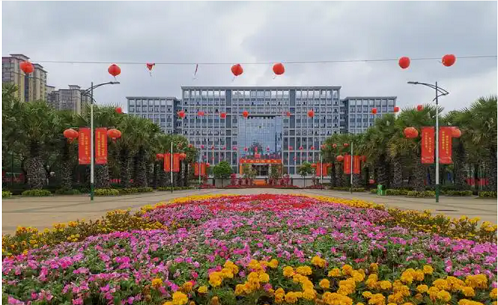Qiongshan District, Haikou City
中文
- Profile Jurisdictions GOV DEPARTMENTS Cultures Travelling Educate
- Qiongshan is known as Zhuya, Jiedu, Tortoiseshell, Shecheng, Yancheng, Yazhou, Qiongzhou, Qiongshan County and Qiongtai in ancient times. As early as in the Han Dynasty, it belonged to Tortoiseshell County of Zhuya County, and was named after the tortoiseshell shells that were abundant in the area. During the Sui Dynasty, Yanlu County was set up in the east of Tortoiseshell County. In the fifth year of Tang Wude (622), Yanlu was changed to Yancheng, and belonged to Yazhou. Between the fifth year of Tang Wude (622) and the fifth year of Song Kaibao (972), the seat of Yazhou was located in present-day Qiongshan). In the first year of the Tang Dynasty (627), Yancheng was changed to Shecheng, and a part of Shecheng was divided to set up Qiongshan County. Song Dynasty, according to the household, the conditions of the capital land is divided into hope, tight, on, in, under the five counties, Hainan Island, only Qiongshan belongs to the middle, the rest of the county are lower. Qiongshan by the Tang since the focus on development, economic and cultural has been in the leading position on the island, for the history of South China's earliest and best development of the region.
“Qiongshan” the origin of a, according to the ‘Record of Public Opinion’ in ”ten miles south of the province has Qiongshan, soil and stone more white, like jade and moist, the county this name.” “Qiongshan County Records” also contains ”because of the territory of the white stone all (today's Koshi Town Xinmin area) there is a mountain called Qiongshan, soil and stone white and moist as jade, then the mountain name of the county name.” In the first year of the Tang Dynasty (627), the old system was abolished and a new county was established. The incumbent civil and military officials remembered the strange encounter of the previous year's excursion to Baishi Mountain, and proposed that the name Qiongshan be taken to mean that the white stones of Baishi Mountain south of the city were as clean and moist as jade. This suggestion was quickly adopted, and the newly established county was named Qiongshan County. In the fifth year of the Tang Dynasty (631), Qiongzhou was established, and the state capital was located in the present-day Old State Town. Song Kaibao four years (971 years) moved to rule today's capital city, Ming Hongwu three years (1370 years) set up the Qiongzhou House, to the Qing Dynasty, Qiongshan County is the seat of the Qiongzhou House, so the capital city so named. Since the Ming Dynasty, Qiongzhou upgraded to the early years of the Republic of China, Qiongshan has been the political, economic and cultural center of Hainan.
Qin Dynasty Qiongshan County land belongs to the elephant county border.
In the first year of Yuanfeng of Han Dynasty (110 B.C.), the land of Qiongshan County belonged to two counties of Zhuyi County, namely, Dudu and Taimao. In the third year of the first Yuan (46 BC), it belonged to Zhu Lu County of Hepu County. Jianwu nineteen years (43 years) in April, changed Zhu Lu County for Zhuya County, Qiongshan County land belongs to Hepu County Zhuya County.
Three Kingdoms East Wu Chi Wu two years (239 years), change Zhu Ya County for Zhu Lu County, belonging to Zhu Ya County, Qiongshan County land belongs to Zhu Lu County.
In the first year of Taikang of Jin Dynasty (280), the land of Qiongshan County belonged to Zhu Lu County of Hepu County.
Liang Datong years (525-546), Qiongshan County land belonged to Zhuyi County Zhu Lu County.
Sui Daye three years (697), Qiongshan County land belongs to Zhuyi County Yanlu, Wude County, Daye six years (610), Wude County into Shecheng County, Qiongshan County land belongs to Yanlu, Shecheng County.
Tang Wude five years (622), change Yan Lu for Yan County, belonging to Yazhou.
Tang Zhenguan first year (627), began to set up Qiongshan County.
Tang Zhenguan five years (631), set up Qiongzhou (rule now Qiongshan old state), Qiongshan County under the Qiongzhou.
In the first year of Tang Tianbao (742), Qiongzhou was changed to Qiongshan County, and Qiongshan County was called Qiongshan County Attachment Contour in Qiongshan County.
In the first year of Qianyuan of the Tang Dynasty (758), Qiongshan County was changed to Qiongzhou, and now Qiongshan County spans Qiongzhou Annexed Contours and Shecheng County of Yazhou.
During the Five Dynasties and Ten Kingdoms period, Nanhan was under the same system as Tang.
In the fifth year of Kaibao of Song Dynasty (972), the rule of Qiongzhou was moved from the present Old Prefecture to the present Prefecture. The land of Qiongshan County now straddles Qiongzhou and Shecheng County.
Song Xining four years (1071), the abolition of Shecheng into Qiongshan County, belonging to the Qiongzhou. Six years (1073), Qiongshan County, belonging to the Qiong tube Pacification Division.
Ming Hongwu three years (1370), Qiongshan County under the Qiongzhou Prefecture.
In June 1949, Qiongshan County under the Hainan Special Administrative Region.
In April 1950, Qiongshan County Government was stationed in Qiongcheng Town (now Fucheng).
In 1952, Qiongshan County Government moved to Lingfu.
In 1955, Qiongshan County Government moved back to Fucheng (Qiongcheng Town was renamed Fucheng Town).
In 1988, Qiongshan County came under Hainan Province.
On January 24, 1994, approved by the State Council, Qiongshan County was abolished and established as a city, and on April 8, Qiongshan City was formally established.
On October 16, 2002, Qiongshan, Haikou administrative division adjustment, analysis of Qiongshan City reset Qiongshan District. on January 1, 2003, Qiongshan District was officially established.
October 16, 2002, the State Council abolished Qiongshan City and Haikou City, Xiuying District, Xinhua District, Zhendong District, the former Qiongshan City and Haikou City, the former Xiuying District, Xinhua District, Zhendong District, the establishment of the administrative area of Haikou City, Xiuying District, Longhua District, Qiongshan District, Meilan District.
Administrative division
When Qiongshan City was established in 1994, it had 24 towns and 2 townships under its jurisdiction: Fucheng Township, Yunlong Township, Yongxing Township, Hongqi Township, Sanmenpo Township, Dapo Township, Tanwen Township, Kazi Township, Crossroads Township, Xinpo Township, Yanfeng Township, Yanhai Township, Sanjiang Township, Roughly Po Township, Xianlai Township, Laozhou Township, Dongshan Township, Zuntan Township, Longqiao Township, Longtang Township, Lingshan Township, Dongying Township, Mei'an Township, Shishan Township, Meirenpo Township and Xinmin Township.
At the end of 1995, Qiongshan City, jurisdiction over 26 townships, 226 village committees, 2103 natural villages, 3 street neighborhoods, within the territory of Hongming, Dongchang, Guilin Yang, Sanjiang 4 state-owned farms. Municipal seat Fucheng Town.
At the end of 2001, the administrative division of Qiongshan City with the year 2000. Municipal government seat Fucheng town. Fucheng Town and Haikou City are linked together, constituting a pattern of “one city, two cities”.
On October 16, 2002, Qiongshan District jurisdiction of the former Qiongshan City, Fucheng Town (Xue Village, except Dazheng Village), Longtang Town, Yunlong Town, Hongqi Town, Laozhou Town, Sanmenpo Town, Azi Town, Dapo Town and Haikou City, the former Zhendong District of the Guoxing Street, and the Lantian Street of the Mipu Neighborhood Committee, Daokai Neighborhood Committee, the district government is located in the town of Fucheng Jianguo Road.
In 2013, Fucheng Town was abolished and divided into Fucheng Street, Riverside Street and Fengxiang Street. The government of Qiongshan District is stationed at No. 1 Jianguo Road, Fucheng Street.
In 2019, the government of Qiongshan District is stationed at No. 1 Huimin Road, Fucheng Street.
As of 2017, Qiongshan District has jurisdiction over (Fengxiang, Fucheng, Binjiang, Guoxing) 4 streets, (Yunlong, Longtang, Hongqi, Sanmenpo, Laozhou, Dapo, Koshi) 7 towns, and 2 townships, such as Lingfei Tropical Crops Farm and Changchang Coal Mine; 71 established villages, 34 communities, 718 natural villages, 919 villagers' groups, and 199 residents' groups. District government is located in Beichongxi community.
contact details
Tel:00-86-0898-65884012
Address:District Government Office Building, No. 1 Huimin Road, Qingshan District, Haikou City, Guangdong Province, China
Working hours:Monday to Friday 8:30 a.m.-12:00 p.m. 14:00-17:30 p.m. Except for legal holidays.
